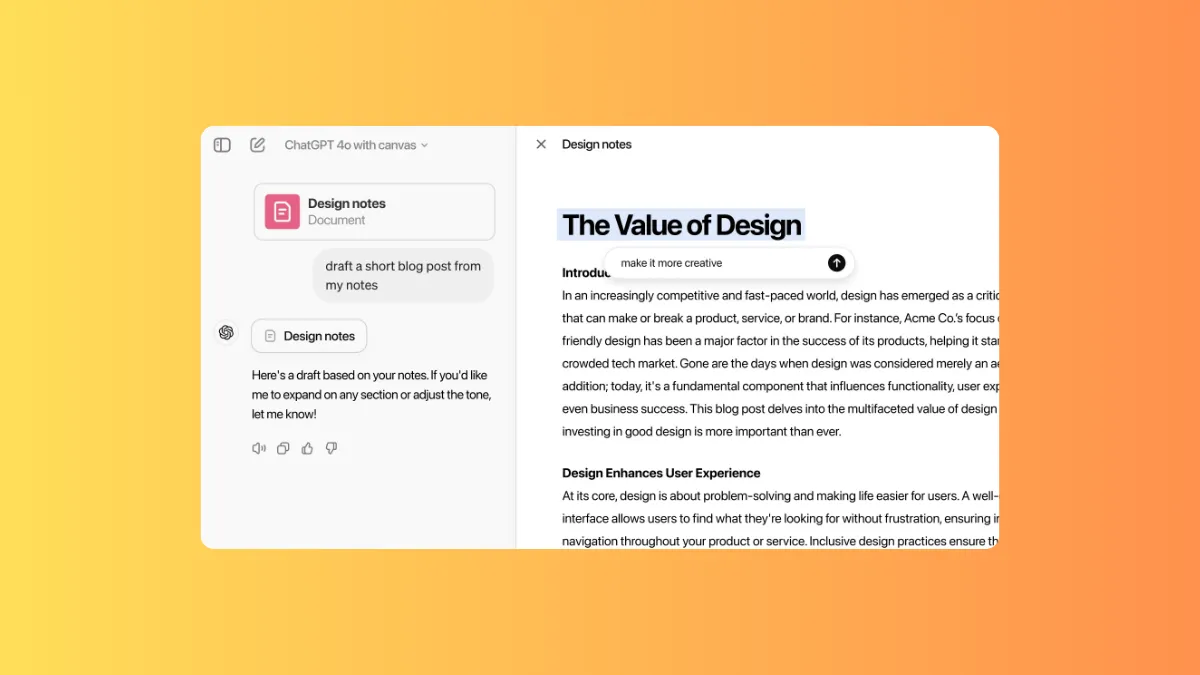Folks over at OpenAI have released a new interface for ChatGPT – Canvas – that'll make it easier to use it for coding and writing projects. Still in Beta, Canvas is rolling out to ChatGPT Plus and Teams users today, with Enterprise and Edu users getting access to it next week. The company says that Canvas will be rolled out to free users as well once the product is out of beta, but there's no timeline on when that will be.
OpenAI says that the model, 'ChatGPT-4o with Canvas', can be selected from the drop-down menu manually "while in beta." This suggests the selection process might change once the feature is out of beta.
The company also says that ChatGPT can also automatically detect and open Canvas in useful scenarios. OpenAI has spent significant time on training the model so it won't trigger Canvas for prompts where it isn't required. For example, a prompt like Write a blog post about the history of coffee beans is supposed to trigger Canvas, whereas it will avoid triggering it for a prompt like Help me cook a new recipe for dinner.
Users can also include the words use canvas in their prompts to open Canvas and this can even be done for your existing projects in ChatGPT where changing the model from the drop-down is no longer an option.
Canvas opens in a separate window which makes it easy to collaborate with ChatGPT on longer writing or coding projects. While initial impressions make it seem similar to Artifacts in Claude from Anthropic, the tool is quite different. Canvas will open in a separate window on the right, with your chat available on the left.

People who frequently use ChatGPT for writing and coding tasks would agree that it could be a bit of a hassle when you want the chatbot to make some specific changes and track all those changes. The back and forth of copy-paste or tuning your prompt could be mind-boggling.
With Canvas, the process becomes extremely easy. Not only is it easier to suggest changes to the chatbot and track them, but you can also make edits to the output yourself. At any time, it's also possible to revert to a previous version using the back button in Canvas. The whole setup is overall more practical and would make a stark difference to your workflow.
Canvas for writing
There are different tools available for writing and coding tasks in Canvas. For writing, you can use the following writing shortcuts, available from the menu in the bottom-right of the Canvas window.
- Suggest edits: This allows you to select particular text from within the output to get inline suggestions and feedback from ChatGPT. You can also ask ChatGPT to make particular edits to the selected text.
- Adjust length: Make the length of the document shorter or longer using a slider.
- Reading level: Change the reading level for the intended audience, such as 'Kindergarten', 'Middle School', 'College', etc.
- Add final polish: Allows you to check for grammar, consistency, clarity, etc.
- Add emojis: Adds any relevant emojis according to the text.
Source: OpenAI
Canvas for coding
Canvas includes these specialized tools in the menu when you're using it for coding.
- Review code: Similar to writing, this lets you select certain parts of the code to get inline suggestions and feedback from ChatGPT to improve your code as well as allows you to make requests to the chatbot for edits to only the selected part.
- Add logs: Adds print statements in the code to help you understand and debug it better.
- Add comments: Inserts comments in the code to make it easier to understand.
- Fix bugs: Detects and fixes bugs in the code to resolve errors.
- Port to a language: Allows you to port your code to other languages like JavaScript, TypeScript, Python, Java, C++, or PHP.
Source: OpenAI

